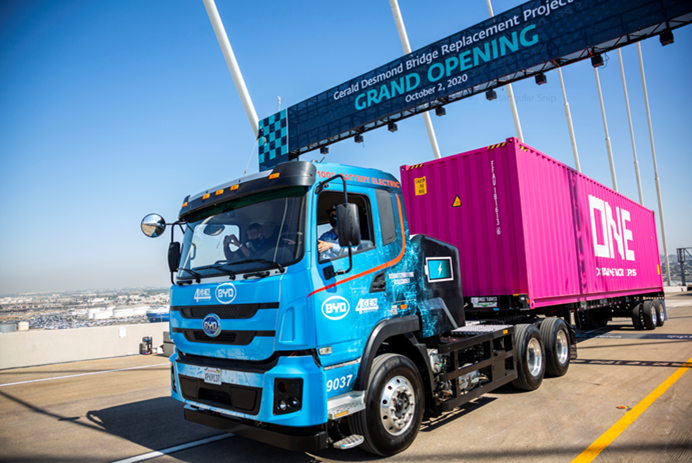
Port of Long Beach boosts push for Zero-Emissions trucks
At least 10% of Clean Truck Fund Rate set aside for truck incentives
To support a goal of a zero-emissions truck fleet by 2035, the Port of Long Beach will start collecting its Clean Truck Fund Rate on April 1, 2022, as approved by the Long Beach Board of Harbor Commissioners today.
The rate for nonexempt trucks of $10 per twenty-foot equivalent unit – a standard measure for one 20-foot-long cargo container – was set in March 2020 by the ports of Long Beach and Los Angeles to encourage the trucking industry to invest in cleaner vehicles and reach zero emissions. Zero-emissions trucks are exempt from the rate, and the Port of Long Beach has approved an expiring exemption for the cleanest natural gas-powered trucks as a transitional step to a future when zero-emissions cargo trucks are widely available.
The Clean Truck Fund rate is expected to generate $90 million in the first year or $45 million per port. As part of Monday’s action, the Board approved an initial funding prioritization for both low-nitrogen oxides and zero-emissions trucks, with at least 10% of the funds to be provided to zero-emissions trucks.
“As cargo volume continues to break records, it’s critical that we transition to a zero-emissions fleet,” said Long Beach Mayor Robert Garcia. “Our Clean Truck Fund is a bold step forward towards cleaner air and addressing our climate crisis.”

Harbor Commissioner Steven Neal
“We are the Green Port,” said Harbor Commission President Steven Neal. “Speeding progress toward the zero-emissions trucks goal is important, in spite of the business uncertainties created by the pandemic. There should never be any doubt that we will fulfill this promise. This rate allows us to balance aggressively pursuing zero-emissions goals with economic vitality and competitiveness. We have a responsibility to find solutions to protect public health in vulnerable communities.”
“The Port of Long Beach is known worldwide for our record of environmental achievement and leadership,” said Port of Long Beach Executive Director Mario Cordero. “Reaching zero emissions will take intense collaboration among our trucking and other goods movement partners. The good news is that we’ve already achieved a great deal with our Clean Truck Program. This is one more step toward a cleaner future we will all be proud of.”
Phasing out older, more polluting trucks has been key to clean air gains the San Pedro Bay ports have made since the original Clean Truck Program was launched in 2008. Diesel emissions from trucks have been cut by as much as 97% compared to 2005 levels. Trucks remain the Port’s largest source of greenhouse gas emissions and the second-highest source of nitrogen oxides, a contributor to regional smog formation.
The Clean Air Action Plan (CAAP) has established a goal of zero-emissions trucks by 2035. A key component of the overall strategy to transition to a zero-emissions truck fleet is an updated Clean Truck Program incentivizing the development and adoption of new technology.
Updated in 2017, the CAAP contains a comprehensive strategy to accelerate progress toward a zero-emissions future while protecting and strengthening the ports’ competitive position in the global economy. Since 2005, port-related air pollution emissions in San Pedro Bay have dropped 89% for diesel particulate matter, 63% for nitrogen oxides, and 97% for sulfur oxides. Targets for reducing greenhouse gases (GHGs) from port-related sources were introduced as part of the 2017 CAAP Update. The document calls for the ports to reduce GHGs to 40% below 1990 levels by 2030 and 80% below 1990 levels by 2050. The CAAP was originally approved in 2006.









